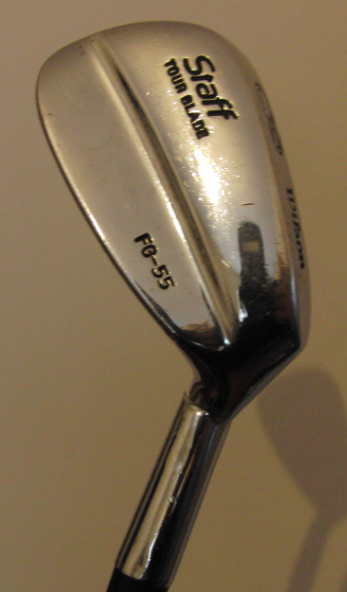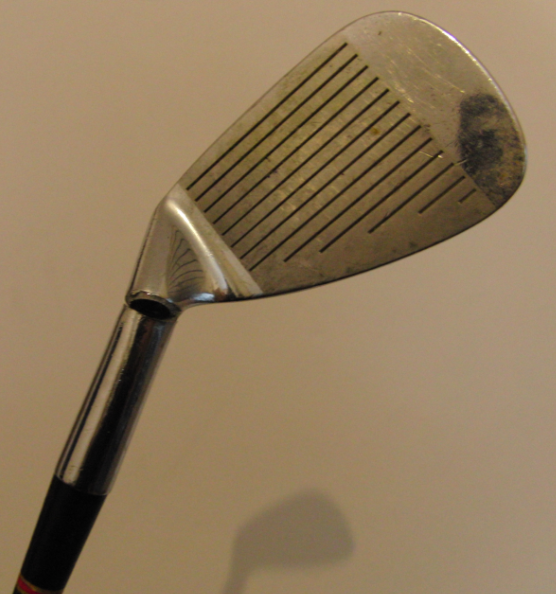Nice work man!
By the way, I just did the lofts and lies on a set of Hogan precisions from the early fifties.
The heads needed only 2 or 3 degrees of flattening to get to lag’s specs; they have virtually no offset and the lofts were a degree or so stronger than the competion. I’m pretty sure they hadn’t been adjusted before.
These guys knew what they were doing back then; I like to think that Hogan himself made sure that the setup of those early sets was to his liking.
Bollocks!


That’s only the second blade I’ve ever snapped.
where is a good place to get a bending bar??
i’ve got my vice rigged up and i’ve been able to flatten old clubs with an 18 "
plumbing wrench…i measure them by eye compared to a set i had a local guy do and that seemes to work. i have
found that about 2 grunts equals about 5 degrees…very scientific.
i just removed the offset on an old forged head i had laying around, but i’m thinking it may be time to upgrade the
bending bar.
Mitchell has a reputation for being the best, but expensive.
mitchellgolf.com/catalog/Lof … -24-1.html
MR3 has a reputation of being just as good as Mitchell, but half the price.
mr3golfdesigns.com/accessories.htm
Golfsmith has the lowest reputation and the lowest price.
golfsmith.com/product/300264 … ending-bar
Shouldn’t you heat the clubs up first by letting them lie in the sun all day or some other method before bending to reduce the risk of snapping?
Won’t be necessary except if your clubs are stored in a very cold place. Room temp should be good enough. If you want to heat them, just heat them with a blow torch for a few seconds. Not too long or the epoxy bond might break ![]()
![]()
thanks photonn, i like the looks of that mr3 bar!
Yes,
You have to be very careful heating with a torch… and the epoxy can weaken. Room temp should be fine.
The only club I have broken was a modern forged blade. It was certainly not as soft as the older forged blades.
I don’t like bending the modern clubs… and the necks are too short to properly remove offset.
I don’t dislike modern clubs because they are new, I just don’t see them as being designed properly for a hitting procedure.
Good technology should not be evaluated on when it was made, but how it performs.
is it best to flatten then remove offset, or vice versa or does it matter?
i’ve only flattened a set with no off set and have only removed offset from a couple of heads that
i wouldn’t bother to flatten…for expirements sake.
thanks
I do them both kind of at the same time… but I do usually pull back or weaken the loft, then I push strong and flat in one motion… or a series of little bumps depending on how the metal feels…
There is really an art to this… I get better and better at it all the time. A lot of the process is just really getting to know your machine and your bending bar and experience with a variety gear.
Yeah that would be the way these guys here would look at you…like a deer in headlights…say what would you want to do that for…the true clubmaker is an lost art…
I just checked my MP-14’s…and my Mizuno T-zoid pro’s…they look to me that they have some offset…but according to the specs they say they don’t have any…can somebody shed some light on this subject…Thanks, Kenny
MP-29 have no offset, actually a very slight bit of on-set
MP-14 have a slight bit of onset
T-Zoid have more offset
Some offset will have been added if the lofts have been bent strong.
When you do this…how do you know that you have taken the off set off…I assume its just the way it looks…no machine or device to measure it after you do this…
I like the ball to be hitting the sweetspot right down the center of the club for irons. So for most clubs that is going to be about the 3rd groove for longer irons, and maybe the 4th or 5th groove for short irons and wedges. I set up offset progressively. More face progression into the shorter irons and wedges because the ball is going to be making contact farther up the face as loft is added.
Get your clubs set up right. .it makes a HUGE difference.
Most of the other stuff people are concerned with is simply nonsense.
I like the ball to be hitting the sweetspot right down the center of the shaft for irons. So for most clubs that is going to be about the 3rd groove for longer irons, and maybe the 4th or 5th groove for short irons and wedges. I set up offset progressively. More face progression into the shorter irons and wedges because the ball is going to be making contact farther up the face as loft is added.
Get your clubs set up right. .it makes a HUGE difference.
Most of the other stuff people are concerned with is simply nonsense.
What you really need in a golf club is that the dead weights are progressive and CONSISTENT. You don’t jump from a 15 ounce iron to a 10 ounce driver. Never swing any iron that weighs less than 14 ounces. Progress weights from 14 to 15 … up to 17 to 18. Anyone who argues with you… send them here so I can play them for their bank account.
Bend them as flat as you can handle if you want to take advantage of what geometry and physics are offering here. Remove offset you can hit hard with the pivot rotation and not have to flick at the ball with the hands.
Put in stiff shafts so the head is not torquing, toe dipping and twisting around unnecessarily. Start with a long iron that has a firm enough shaft that you can’t feel it bending. Then step down in 1/2 inch increments into your short irons and wedges. Set your lengths at half inch increments. Forget the word swing weight ever existed.
Set your lofts to define your shot trajectory needs. Use hard grips so you can feel the vibration from the shaft. Tight suspension, no Cadillacs here. Make sure your grip will work in a down pour without a glove. You will thank me later on that one.
Hey, lagpressure
Are you saying that when you do this …you want the hosel of the club to lined up with the 3rd grove on the face for long irons…and then for shorter irons the 4th or 5th groove…so basically I’m pushing the face forward…if I understand you … Thanks, Kenny
Tit-
I believe what Lag was referring to is that you want the center of the hosel/shaft to line up with the third groove of the long irons and the fourth in the short irons. That means that there will be a gradual amount of face progression, naturally, as you move into the shorter irons, because the higher loft will kick the leading edge forward.
And btw, there is a device made for measuring every spec for your irons and woods, including offset and face progression and everything else. They seem to be quite handy and very useful. Certainly beats guess work. Here are links to some of the companies that make them. They range in price from fairly reasonable, to absolutely outrageous!
Golfworks- they are called Maltby golf club guages
golfworks.com/search.asp_Q_i … A_c_E_1894
Golf Mechanix/Auditor-
golfmechanix.com/Items.asp?P … ption=Golf club head surveying gauges
Hope this helps,
JN
Hey Club Benders,
I’ve got some new insight to me on how to remove offset from irons by yourself. First I bend the club a few degrees strong down low near the head. Then I go to a “3-clamp system” and bend the top of the hozel back weak…The first clamp holds the newly bend hosel in place. The second clamp holds the first clamp to a fixed shelf that the bending machine is mounted on. The third clamp is placed in such a way that it won’t let the second clamp slip/move…
The above works like a charm and still more practice. But I think this will work out as I bend more clubs.